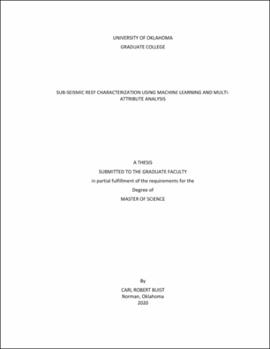| dc.description.abstract | Historically, Silurian reef complexes in the Michigan Basin have been largely identified using 2D seismic surveys with very little research focusing on characterizing these reefs (morphology, internal architecture, reservoir quality, etc.) using 3D seismic data. To date, the only 3D study, conducted by Toelle and Ganshin (2018), had sub-optimal resolution due to a thick glacial overburden, no core/petrophysical data, and a very small number of wells with geophysical logs for correlation. This study is the first to incorporate a high-resolution 3D dataset with a well-studied and data-rich reef reservoir that attempts to correlate seismic attributes to petrophysical properties through machine learning and self-organizing maps (SOMs). This study provides a workflow for quantitative seismic attribute analysis derived from a data-rich reef analog field in SE Michigan that can be used as a blueprint for characterizing reefs with less data (core/logs) for the purpose of future exploration, gas storage, and CO2 sequestration efforts.
The workflow construction began by choosing the most data-rich reef reservoir, Puttygut reef, from a field on the SE side of the Michigan Basin. A suite of structural and frequency-based attributes were calculated from pre-stack time migrated (PSTM) seismic data. A subset of those attributes were then selected by an interpreter to be used as inputs to the SOM, which is an unsupervised machine learning algorithm. The SOM is able to take the input data that is usually viewed at the wavelet scale and transforms it to have beneficial information at the sample scale.
A strong relationship between certain combination percentages of attributes and certain sections of the reef with specific porosity (and potentially permeability) was found after the SOM was calculated and compared to the well log data in the Puttygut reef. Areas with high permeability and porosity correlated well with attribute combinations high in average frequency and spectral decomposition at 29 and 81 Hz. Areas with high porosity and varying permeability correlated well with attribute combinations high in average frequency and spectral decomposition at 29, 57, and 81 Hz. Areas with intermediate porosity correlated well with attribute combinations high in average frequency and spectral decomposition at 29 and 57 Hz. The created workflow was then applied to two nearby reefs. The results were very similar, showing the same attribute combinations correlating with the same sections of the reefs with similar porosity and permeability values.
The developed workflow from this study was able to consistently find a relationship between certain sections of a reef reservoir with a specific range of porosity and permeability on the SE side of the Michigan Basin. | en_US |
